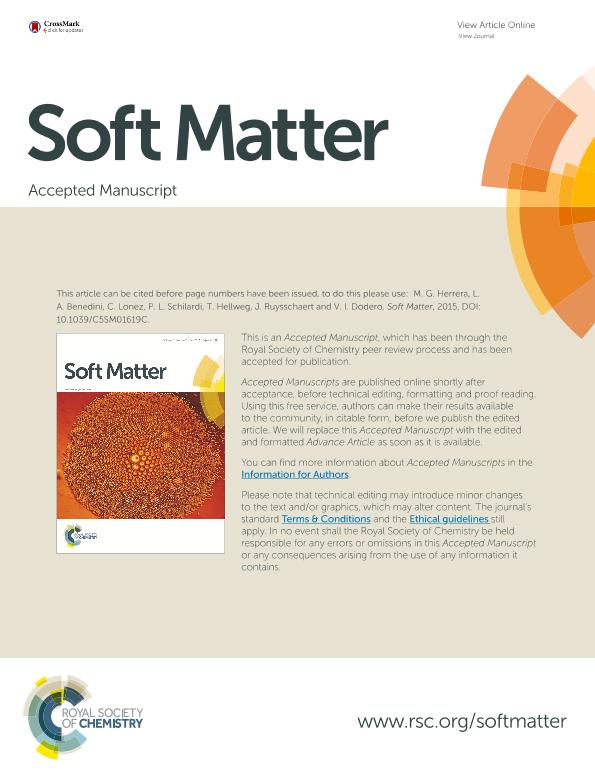Mostrar el registro sencillo del ítem
dc.contributor.author
Herrera, Maria Georgina

dc.contributor.author
Benedini, Luciano Alejandro

dc.contributor.author
Lonez, C.
dc.contributor.author
Schilardi, Patricia Laura

dc.contributor.author
Hellweg, T.
dc.contributor.author
Ruysschaert, J. M.
dc.contributor.author
Dodero, Veronica Isabel

dc.date.available
2018-04-03T18:52:56Z
dc.date.issued
2015-09
dc.identifier.citation
Herrera, Maria Georgina; Benedini, Luciano Alejandro; Lonez, C.; Schilardi, Patricia Laura; Hellweg, T.; et al.; Self-assembly of 33-mer gliadin peptide oligomers; Royal Society of Chemistry; Soft Matter; 11; 44; 9-2015; 8648-8660
dc.identifier.issn
1744-683X
dc.identifier.uri
http://hdl.handle.net/11336/40544
dc.description.abstract
The 33-mer gliadin peptide, LQLQPF(PQPQLPY)3PQPQPF, is a highly immunogenic peptide involved in celiac disease and probably in other immunopathologies associated with gliadin. Herein, dynamic light scattering measurements showed that 33-mer, in the micromolar concentration range, forms polydisperse nano- and micrometer range particles in aqueous media. This behaviour is reminiscent of classical association of colloids and we hypothesized that the 33-mer peptide self-assembles into micelles that could be the precursors of 33-mer oligomers in water. Deposition of 33-mer peptide aqueous solution on bare mica generated nano- and microstructures with different morphologies as revealed by atomic force microscopy. At 6 μM, the 33-mer is organised in isolated and clusters of spherical nanostructures. In the 60 to 250 μM concentration range, the spherical oligomers associated mainly in linear and annular arrangements and structures adopting a “sheet” type morphology appeared. At higher concentrations (610 μM), mainly filaments and plaques immersed in a background of nanospherical structures were detected. The occurrence of different morphologies of oligomers and finally the filaments suggests that the unique specific geometry of the 33-mer oligomers has a crucial role in the subsequent condensation and organization of their fractal structures into the final filaments. The self-assembly process on mica is described qualitatively and quantitatively by a fractal diffusion limited aggregation (DLA) behaviour with the fractal dimension in the range of 1.62 ± 0.02 to 1.73 ± 0.03. Secondary structure evaluation of the oligomers by Attenuated Total Reflection FTIR spectroscopy (ATR-FTIR) revealed the existence of a conformational equilibrium of self-assembled structures, from an extended conformation to a more folded parallel beta elongated structures. Altogether, these findings provide structural and morphological information about supramolecular organization of the 33-mer peptide, which might offer new perspectives for the understanding and treatment of gliadin intolerance disorders.
dc.format
application/pdf
dc.language.iso
eng
dc.publisher
Royal Society of Chemistry

dc.rights
info:eu-repo/semantics/openAccess
dc.rights.uri
https://creativecommons.org/licenses/by-nc-sa/2.5/ar/
dc.subject
Self-Assembly
dc.subject
Gliadin
dc.subject
Celiac Disease
dc.subject
Biophysics
dc.subject.classification
Otras Ciencias Químicas

dc.subject.classification
Ciencias Químicas

dc.subject.classification
CIENCIAS NATURALES Y EXACTAS

dc.title
Self-assembly of 33-mer gliadin peptide oligomers
dc.type
info:eu-repo/semantics/article
dc.type
info:ar-repo/semantics/artículo
dc.type
info:eu-repo/semantics/publishedVersion
dc.date.updated
2018-03-28T16:56:55Z
dc.journal.volume
11
dc.journal.number
44
dc.journal.pagination
8648-8660
dc.journal.pais
Reino Unido

dc.description.fil
Fil: Herrera, Maria Georgina. Consejo Nacional de Investigaciones Científicas y Técnicas. Centro Científico Tecnológico Conicet - Bahía Blanca. Instituto de Química del Sur. Universidad Nacional del Sur. Departamento de Química. Instituto de Química del Sur; Argentina
dc.description.fil
Fil: Benedini, Luciano Alejandro. Consejo Nacional de Investigaciones Científicas y Técnicas. Centro Científico Tecnológico Conicet - Bahía Blanca. Instituto de Química del Sur. Universidad Nacional del Sur. Departamento de Química. Instituto de Química del Sur; Argentina
dc.description.fil
Fil: Lonez, C.. University of Cambridge; Reino Unido
dc.description.fil
Fil: Schilardi, Patricia Laura. Consejo Nacional de Investigaciones Científicas y Técnicas. Centro Científico Tecnológico Conicet - La Plata. Instituto de Investigaciones Fisicoquímicas Teóricas y Aplicadas. Universidad Nacional de La Plata. Facultad de Ciencias Exactas. Instituto de Investigaciones Fisicoquímicas Teóricas y Aplicadas; Argentina
dc.description.fil
Fil: Hellweg, T.. Universitat Bielefeld; Alemania
dc.description.fil
Fil: Ruysschaert, J. M.. Université Libre de Bruxelles; Bélgica
dc.description.fil
Fil: Dodero, Veronica Isabel. Consejo Nacional de Investigaciones Científicas y Técnicas. Centro Científico Tecnológico Conicet - Bahía Blanca. Instituto de Química del Sur. Universidad Nacional del Sur. Departamento de Química. Instituto de Química del Sur; Argentina
dc.journal.title
Soft Matter

dc.relation.alternativeid
info:eu-repo/semantics/altIdentifier/doi/http://dx.doi.org/10.1039/c5sm01619c
dc.relation.alternativeid
info:eu-repo/semantics/altIdentifier/url/http://pubs.rsc.org/en/Content/ArticleLanding/2015/SM/C5SM01619C
Archivos asociados
